Introduction
Mortality rate in the UK has improved largely in the UK, with only 12 percent people dying before the age of 60 in 1999 as compared to 63 percent in 1901 (Hicks & Allen 1999, p. 5). There has been a steady decline in the death rate in the twenty-first century and especially in infant mortality rates. This paper studies the mortality rate in UK based on age, sex, and region. The paper aims to present the trend in mortality rate in the UK and analyse if there are any existing inequality in the rates based on age, sex, or region.
Existing research has shown that there has been a decline in the mortality rate in the UK (Hicks & Allen 1999; Gregory 2008; Judge 2009). However, recent research on mortality rate in the UK has specifically concentrated on the cancer related mortality rate or infant mortality rate as it is considered the key indicator for human development index. A study conducted by Gregory has shown that there has been a great decline in the infant mortality rate in the UK since the early twentieth century and it has been mostly in the rural part of the UK (2008, pp. 774-5). The study used six decimal time-periods in studying infant mortality and used GIS database as the source for secondary data on infant mortality. The study demonstrates that there has been a change in the local geographies in the UK in relation to infant mortality rate (Gregory 2008, p. 792). Another study of infant mortality has concentrated on the inquiring into the socio economic status of the father, the region of birth, mother’s age, and cause of death (Bakeo 2006, p. 128). The study showed that infants born from mothers from West Africa or Asia had the highest death rate and those from UK dies due to immunity related conditions (Bakeo 2006, p. 137). Mortality rate due to cancer has been widely researched upon recently due to increase in the death caused by cancer in the UK (Geraci et al. 2007, p. 1594). Thus, research on mortality rate in the UK has mostly concentrated on the cancer related death and infant mortality rates.
Mortality rate may be defined as the number of deaths in UK per thousand populations. Again female mortality rate is derived from the number of death of females in per thousand female populations. Similarly, age specific rates are calculated for the death of a specified age group within thousand population of that age group.
The aim of the paper is to understand the trend of mortality rate and the difference in the mortality rates based on age, sex, and region. The paper will demonstrate the inequalities in the mortality rates in the UK due to change in age, sex, or region. Further, the paper will also present a cyclical nature of variation in the mortality rates in the UK.
Data
The data for the study has been derived from National Statistics Online published from Office of National Statistics (ONS 2010). Mortality rate in the UK has been observed to be undergoing a decline. Mortality rate in the UK has declined from 25.0 in 1976 to 20 in 2008. Further, by adding a trend line to the graph for the next five years until 2012 it is seen that the mortality rate in UK is expected to fall further as the trend line indicated by the red line declines continuously. Further the linear equation for the trend line that is derived is y = -0.3986x + 24.009 indicating a declining trend in the future of the mortality rate in the UK. With a R2 value close to 1 it can be stated that the future decline in the mortality rate can be positively predicted.
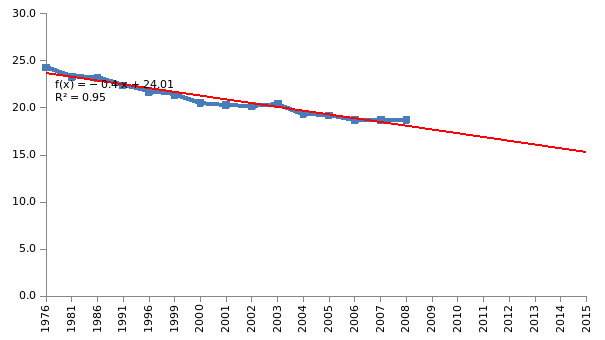
Age
The data on age is again derived from the ONS data. The data presented by ONS aggregated to form five age groups – less than 5 years, 5 to 20 years, 20 to 55 years, 55 to 85 years, and above 85 years. Figure 2 shows mortality rate in UK grouped according to age. This shows that highest mortality rate is found in the age group over 85 years. The second largest mortality rate is found among the age group 55 to 85 years. The lowest mortality rate is found in the age group of 5 to 20 years. Mortality rate at the age group of less than 5 years is 13.2, which is higher than that of age group 22 to 55 years.
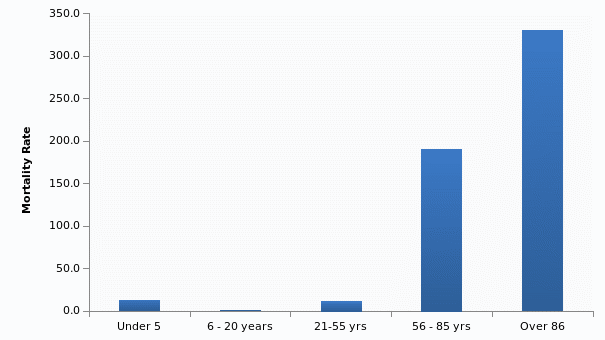
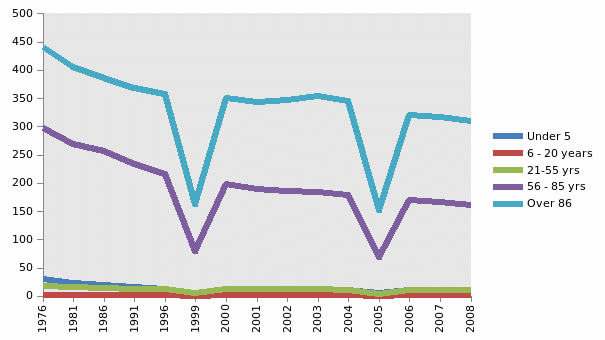
Historically mortality rate in the UK has been gone through different phases. As figure 3 shows, initially from 1976 to 1999, there has been a decline in the mortality rate for all ages, however, there has been a sudden rise in the rate in 2000 and it went back to the 1996 rate. This is mostly evident in the age groups over 55 years. For age groups below 55 years there has been a more gradual decline in the mortality rate.
Figure 4 shows that mortality rate among men is higher than that of women at all age groups. Thus, mortality rate follows the trend of higher for male and lower for females in all age groups as well as for overall mortality rate.
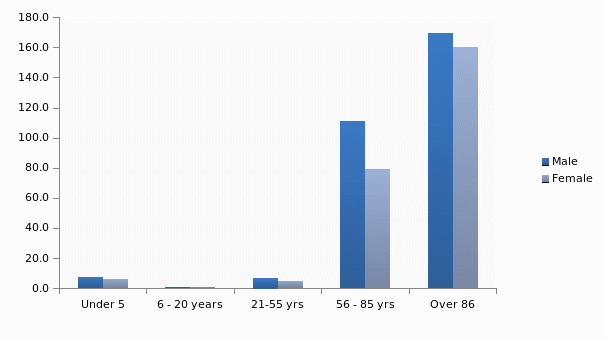
Another point of concern for the human development index is the infant mortality rate (see figure 5). In the UK, the infant mortality rate has been continuously declining. A correlation coefficient done on the male and female infant mortality rates show that there is a positive relationship (correlation coefficient being 0.99) between the two indicating that as one increase, the other also increases (see table below).
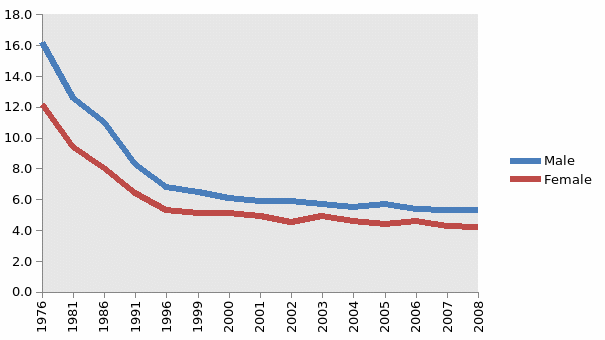
Region
The regions, which are considered for the analysis, are North East, North West, Yorkshire and the Humber, East and West Midlands, East, London, South East, and South West. The data shows that there has been a decline in the mortality rates in all the regions. The highest mortality rate has been in North East region in 2008 and lowest has been in South East.
A descriptive statistics of the region-wise mortality rate is shown in table 2. Mean is calculated using the following formula:
Mean mortality Rate for the Region (µ) =

In this case mean mortality rate is derived by dividing the summation of mortality years of different years, by the number of years. In this example, the distribution has odd number of observations. Thus, in a way median provides the middle value of the dataset. Therefore, median is calculated by the mid-most value of the distribution after it is arranged in ascending order. Mode is the value that occurs maximum times in a distribution i.e. the value which has the largest frequency.
Standard Deviation is calculated using the formula:
Standard Deviation σ =

The maximum mortality rate in the period of 12 years has been in North East with a mean mortality rate for 1996 to 2008 being 11.1. The minimum mean being 7.9 for London region where the mean mortality rate has been the lowest over the period. The standard deviation for London has been 0.9 indicating a widely dispersed data while that in North East has been relatively less dispersed. Further a negative kurtosis for all the regions indicates that their distribution i.e. mortality rate is tapering and not evenly distributed. The lowest standard deviation is derived in case of West Midlands and East region where the mortality rate has clustered around the mean i.e. 10.2 and 9.8 respectively. The highest standard deviation is found for London (0.9), where the mortality rates are expected to be dispersed away from the mean.
Conclusion
The study of the mortality rates statistics of UK shows that there is a trend of historically declining trend of mortality rate and it is expected to decline further in the future. The age wise difference in mortality rate shows that mortality rate for population over 55 years has declined largely in the UK, while the decline in the mortality rate for the population below 55 years has been more gradual. Infant mortality rate has declined too and for both the sexes and in all the regions under consideration, however, the rate of decline is slower. The data analysis and findings gains support from the previous studies that indicated a decline in mortality rate and infant mortality rate. However, it does not adhere to the findings of Gregory. The findings are based solely on the secondary data collected by ONS that may limit the scope of the study largely.
References
Bakeo, AC 2006, ‘Investigating variations in infant mortality in England and Wales by mother’s country of birth, 1983–2001’, Paediatric and Perinatal Epidemiology 20, p. 127–139.
Geraci, M, Birch, JM, Alston, RD, Moran, A & Eden, TOB. 2007, ‘Cancer mortality in 13 to 29-year-olds in England and Wales, 1981–2005’, British Journal of Cancer 97(11) , pp. 1588-1594.
Gregory, IN 2008, ‘Different Places, Different Stories: Infant Mortality Decline in England and Wales, 1851–1911’, Annals of the Association of American Geographers 98(4) , p. 773–794.
Hicks, J & Allen, G 1999, ‘A Century of Change: Trends in UK statistics since 1900’, Research Paper 99/111, House of Commons, London, UK.
Judge, K 2009, ‘Inequalities in infant mortality: Patterns, trends, policy responses and emerging issues in Canada, Chile, Sweden and the United Kingdom’, Health Sociology Review 18(1), pp. 12-24.
ONS 2010, Deaths – National Statistics Online, Web.